I hope you will agree with me when I say there’s a reason we call the best kitchen knives “chef knives.” A good home cook or professional chef is a multitasker, and good chef knives are usually good quality kitchen knives designed to handle multiple jobs.
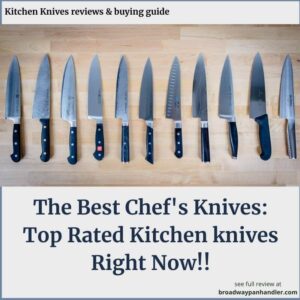
Think of all the slicing and chopping involved in a beef stir-fry or a chicken noodle soup. You want a single tool that can handle it all. But the best chef knife can’t be defined by a single set of features.
It’s all about hand-feel: The right cooking knife should feel almost like an extension of your forearm.
To properly research and test kitchen knives, we talked to three professional chefs, a cooking instructor, and a knife expert, then chopped, diced, and peeled with 10 bestselling chef knives to see which stood out.
In this kitchen knives review, rating and buying guide, you will know which cooking knife is best for home chefs after rigorous testing, and learn how to choose the best chef’s knives for your kitchen.
Our Top Rated Chef Knives
These are the top-rated best chef knives to buy in 2025:
- Best chef knife overall: Mac Knife Professional 8 Inch Hollow Edge Chef Knife.
- Best quality kitchen knife for professionals: Shun Classic Chef Knife.
- Best affordable chef knife on a budget: Victorinox Fibrox Pro Chef’s Knife.
We took real kitchen knives consumer reviews, critics and ratings and tested different knives from popular chef knife brands such as MAC, Wusthof, Victorinox, Zwilling and global. After a series of research and testing cooking knives, our experts were certain the best chef knife for most home chefs is the MAC Knife Professional Series 8-Inch Chef Knife. This is because it is suitable for most cooking needs and has an intuitive design that fits most hand sizes and skill levels.
We have shortlisted the top-quality knives for professional and home chefs below.
Here then is a detailed review of the best chef’s knives:
The Best chef’s knife: Mac Knife Professional 8 Inch Hollow Edge Chef Knife
MAC Knife Professional series 8″ Chef’s knife MTH-80
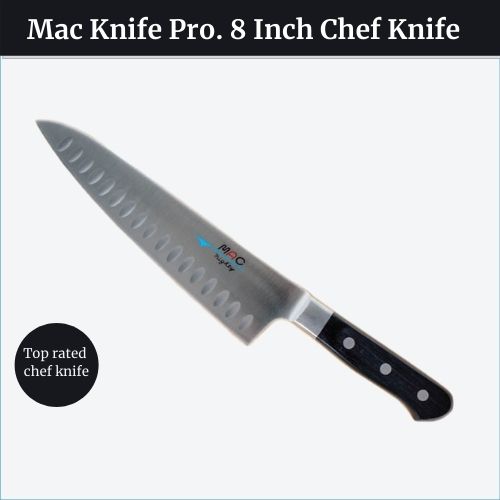
What we liked
- Comfortable to use and maneuverable.
- Balanced weight.
What we didn’t like
- It’s expensive.
Why we picked it
Comfortable to hold and maneuverable.
The MAC Knife Professional Series 8-Inch Chef Knife with Dimples is the brand’s “most popular knife for everyday cooking use”, and it was the most popular knife in our testing room. It’s maneuverable enough to chop mint leaves, peel butternut squash and slice carrots – all with clean cuts without requiring perfect form.
The MAC knife is one of my favorites. The weight/balance is perfect for me. It’s wide enough to keep your food together and it keeps a great edge.
Many home cooks agree that the MAC is a good chef knife for smaller hands and for people who want to make thin cuts. It’s a Japanese-style knife, which means it’s generally going to be smaller than a European-style knife.
Balanced weight.
At 7.1 ounces, the MAC is right in the middle of our contenders in terms of weight. However, the blade is only 1.88 inches across and gives a balanced light weight. In fact, the MAC’s satisfying heft was a running theme, with one of our testers describing the knife as “thin and light, but balanced.”
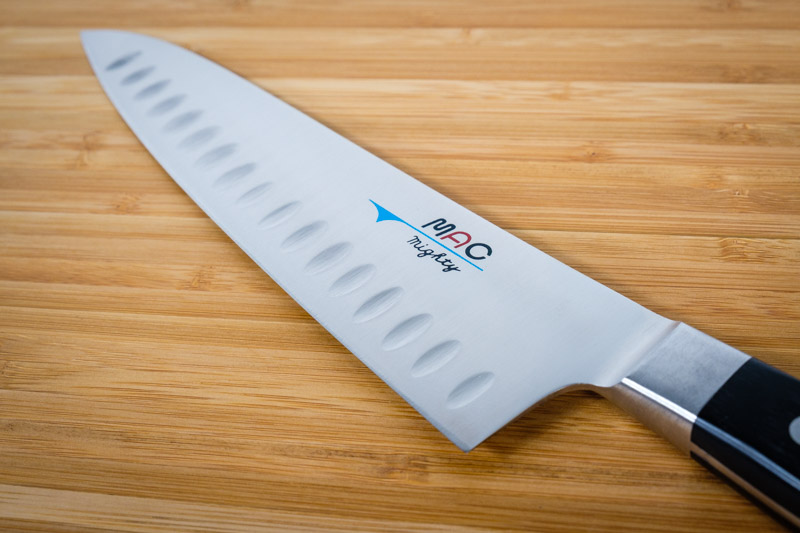
This balance might have been helped along by the MAC’s half-bolster. Two of the three full-bolstered knives that we tested got dinged for feeling “clunky” or “heavy,” while the knife without a bolster felt “almost too light” to some of our testers.
Dimpled blade.
The MAC’s granton edge also known as the “dimples” along the side of its blade are designed to prevent food from sticking to the knife as you slice or chop.
These divots don’t really make a huge difference though, as you can achieve the same results (keep sticky food off your knife) by rubbing the blade of the knife with a little plain vegetable oil before cutting things like garlic or potatoes. However, in our test, we did notice that the MAC accumulated fewer bits of carrot and mint than dimple-less knives.
What you should know and points to consider
It’s expensive.
The MAC is one of the best kitchen knives around, but it comes at a high price. It’s not more expensive than most high-end knives, but if you’re a beginner cook, spending over $100 for a kitchen knife might seem like too much.
That said, if its price isn’t a deal breaker for you, the MAC is a top-quality kitchen knife for beginners and pros alike.
Consumer reports and customer reviews
Satisfied customers that we observered find this kitchen knife sharp and well-made. They appreciate its lightweight design and loved how it makes it easy to handle. The knife is comfortable to use, with a good balance. Some unsatisfied customers, however have differing views on the build quality.
“I am thoroughly impressed by this knife! It is perfectly sharpened, and as long as you take care of it, it turns food prep into an enjoyable task. It even comes in an elegant case that I use for storage, although I wish it came with a good cover or sheath instead of just cardboard. Be careful! This knife is very unforgiving and will easily add skin to whatever you are preparing! I was used to using a chef’s knife that had a rounded/dull rear on the blade, but the rear of this knife is just as sharp as the tip, so you need to be extra careful when using and cleaning the knife.” — Jason
The best quality kitchen knife for professionals: Shun Classic Chef Knife
Shun Classic 8″ Chef’s Knife
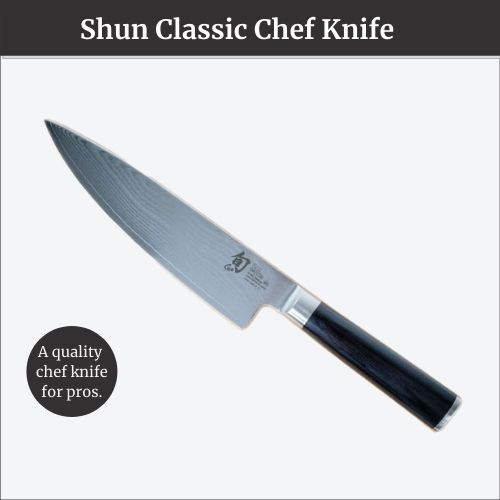
Of all the knives we tested, Shun Classic Chef Knife is the best all-around quality chef knife for your kitchen. Its more expensive than other cooking knives, but thousands of professional cooks and chefs agree it’s worth every penny.
Things we liked
- Functional and beautiful design.
- Unique D-shaped handle for firm grip.
Things we disliked
- It requires high level of maintenance.
Why we picked it
Functional, beautiful design.
The Shun Classic Chef Knife made a vivid impression when we started chopping. Testers had no trouble halving a butternut squash, and the knife was maneuverable enough to peel said squash in “nice long strips.” It was also the only kitchen knife we tested that made that satisfying “shwing” sound when we sliced.
The Shun, like the Mac (our top pick), is a lightweight Japanese knife brand with a half bolster.
I love Shun knives. They’re beautiful, like a functional art piece with great balance and good quality steel. Brownstein
At 7.3 ounces, with a blade that’s 1.8 inches wide, it had a heft and balance similar to the MAC.
Unique D-shaped handle.
The Shun got an overwhelmingly favorable response from experienced chefs for its grip and balanced weight. Surprisingly, some novices liked it better than the Japanese-style Miyabi knives we tested, which had blades and handles that felt stiff and clunky compared to Shun.
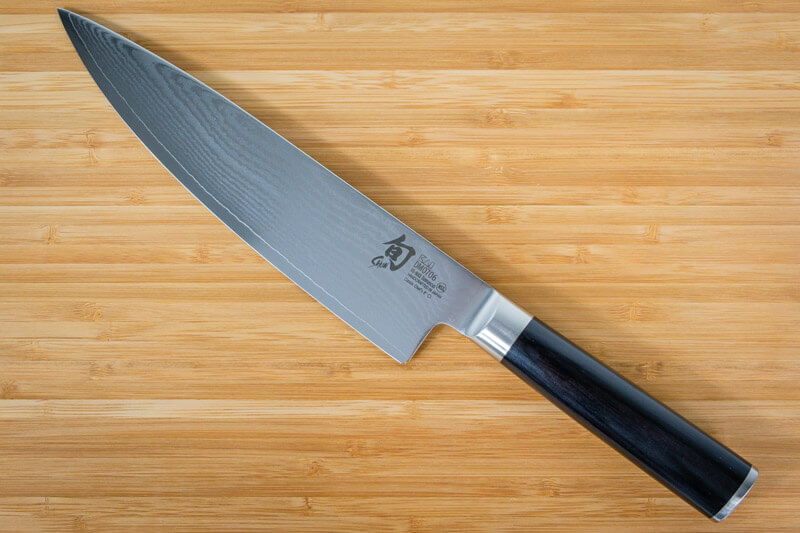
In fact, the Shun’s handle was a standout feature. Rather than being totally round (like some traditional Japanese kitchen knives), it’s D-shaped: The curve of the D fits into the curve of your fingers as you grip the knife.
What you should know and points to consider
It’s not a kitchen knife for beginners
The Shun is clearly designed for people who already know their way around a kitchen. Several novice cooks in our group struggled to maintain a comfortable grip, with one lamenting, “It just doesn’t feel right.” The knife’s spine was also less forgiving, rubbing against index fingers that slid out of a proper pinch grip.
Because the handle is designed with a professional pinch grip in mind, if you’re not maintaining proper form, your mileage may vary. But if you master the right technique, your Shun can stay sharp for a long time.
It requires high level of maintenance.
The trade-off for the Shun’s visual elegance is that the knife requires careful maintenance. The handle is made of a wood/plastic composite, which is more delicate. Hence, constant exposure to water would be bad for it; you’ll need to dry both the knife and its handle thoroughly after use.
It is also worth noting that the knife is Damascus-clad, which means: the blade is made of steel, and then coated with an outer layer of Damascus steel.
The implication of this?
While Damascus on its own is quite strong, when it’s only an outer layer, the knife edge is more likely to chip. In fact, Shun’s website includes this warning in its FAQ: “Chips can happen due to improper cutting technique. Shun Cutlery is designed to be used in a smooth, slicing motion and never in a forceful, up-and-down ‘chopping’ manner.”
What Are People Saying About the Shun Classic 8″ Chef’s Knife?
We found that customers liked this kitchen knife’s sharpness and appearance. They confirmed it stays sharp for a long time, has a great design, and called it a nice investment for chefs of all skill levels. The knife cuts well and slices meats effortlessly and many customers find it comfortable to hold, lightweight and balanced. Others have mixed opinions on its durability.
“This knife is excellent if you don’t want to spend to to much. If you take care of this knife it will take care of you. It sharpens great on stone or steel. The size also works perfect for me because I have smaller hands and this knife allows me to be in more control of the blade. I am a culinary student and would highly recommend it over what (most) schools recommends.” — Fondren
“An absolute work of art, after years of working with the Wasabi line I decided to take a leap in quality and move on to the Shun line and as I expected, Kai did not disappoint me. The knife is sturdy, well balanced, the chestnut shape of the handle allows a solid and secure grip. The steel is amazing, the precise and clean cut if well cared for, a couple of strokes on the stone are enough to give life to the cut. Personally, I recommend it to any employee in the sector. As far as amateurs are concerned, I don’t know whether to recommend it, it’s not just any knife and it must be taken care of so that it can express its full potential. Having said that I can say that it is simply magnificent.” — Andrea Loreto
Best affordable chef knife for beginners: Victorinox Fibrox Pro Chef’s Knife
Victorinox Fibrox Pro Chef’s Knife, 8-Inch
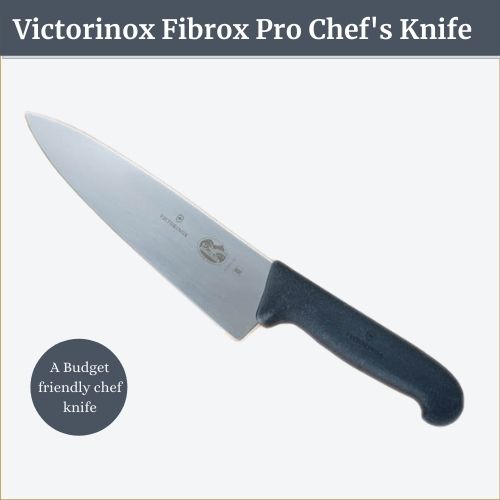
An affordable kitchen knife for home chefs
The Victorinox Fibrox Pro 8-Inch Chef’s Knife is the best affordable cooking knife you can buy for under $50. It’s not the most professional grade knife on the market, but many chefs agree it’s a good chef knife for budget conscious home cooks.
Why we picked it
Budget-friendly and affordable.
The Victorinox Fibrox 8-Inch Pro Chef’s Knife is an excellent option for people who want to start cooking regularly but aren’t yet ready to invest a lot of money into a kitchen knife. It offers a solid performance for around $45.
Many home chefs we talked to agreed that the Victorinox is the best chef knife for people who are on a budget. Commercial kitchens often order this knife for their line cooks. If you’re looking for low cost but respectable quality, the Victorinox is a good chef knife to start with.
European-style knife.
The Victorinox is a European-style knife, meaning the blade is both wider and slightly thicker than the Japanese-style MAC and Shun. It only weighs 6.6 ounces (lighter than both the MAC and Shun), but the blade measures 2 inches across at its widest point.
What we don’t like and points to consider
Plastic handle.
The Victorinox’s handle was its most controversial feature. It’s made of Fibrox, with a slightly textured pattern that offers a no-slip grip even if your hands are wet. Our fingers felt undeniably safe.
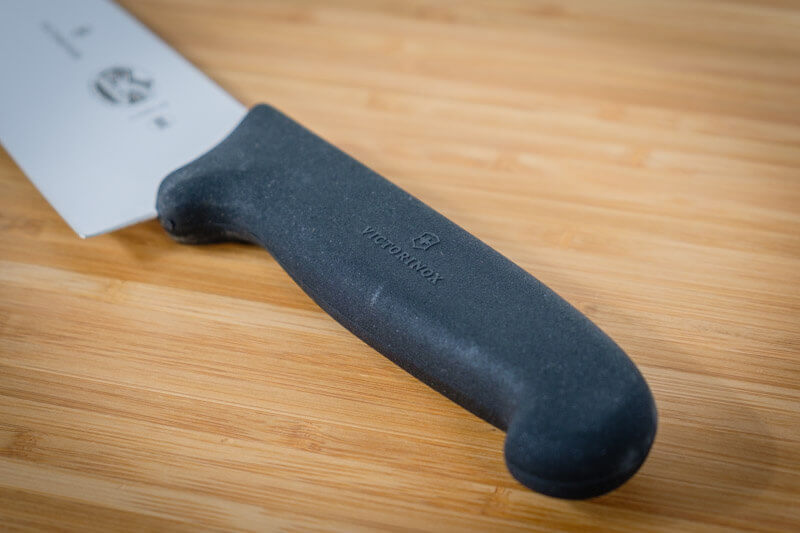
However, most home chefs noted the material seemed “cheap”, even if it’s comfortable. If you’re on a budget and new to cooking, regardless, the Victorinox is a great budget friendly and affordable chef knife.
The Top Rated Kitchen Knives Brand We Tested
- Wusthof
- Global
- MAC
- Shun
- Messermeister
- Victorinox
- Zwilling
- Miyabi
Methodology: How we researched and tested cooking knives to find the best Chef Knives
Different grip styles, budgets, aesthetic tastes, as well as a dozen other minor reasons, determine which knife is best for the task at hand. Hence, it is important to note that there is no absolute best kitchen (chef) knife for every person.
To help you make a guided buying decision when shopping for your next kitchen knife, we looked at the following:
Knife size (Eight-inch knives)
While many aspects of the best chef knife come down to personal preference, blade length and material were rare areas of consensus: All the experts we spoke with recommended 8-inch, stainless steel blades for home cooks.
Eight inches is a great size for chef knives. Residential-kitchen counters, nonindustrial cutting boards, and civilian muscles can’t handle anything much bigger than that. This size allows for both precision tasks like dicing garlic and larger jobs like chopping root vegetables or cuts of meat.
Twelve or 13 is enormous! and is recommended only if you do a lot of cutting really large food. You can see our kitchen knife selection guide to learn more about knife sizes.
Stainless steel blades
We placed an emphasis on stainless steel knives. While there are benefits to ceramic knives such as sharper cut edges and rust prevention, the downsides are significant. Ceramic is extremely brittle, and if you chop into a rogue bone or hit your cutting board at the wrong angle, there’s a good chance that your blade will chip.
Best-performing kitchen knives
To grade on hand-feel, we put our knives through four common kitchen tasks and kept a watchful eye With Deborah Brownstein for good technique. We minced mint leaves, diced carrots, peeled butternut squashes, and butterflied chicken breasts.
Our testing group was comprised of a range of ages, body types, and hand sizes – not to mention vastly different levels of cooking experience. So, we were surprised to find that there was a consensus as to which knives felt best.
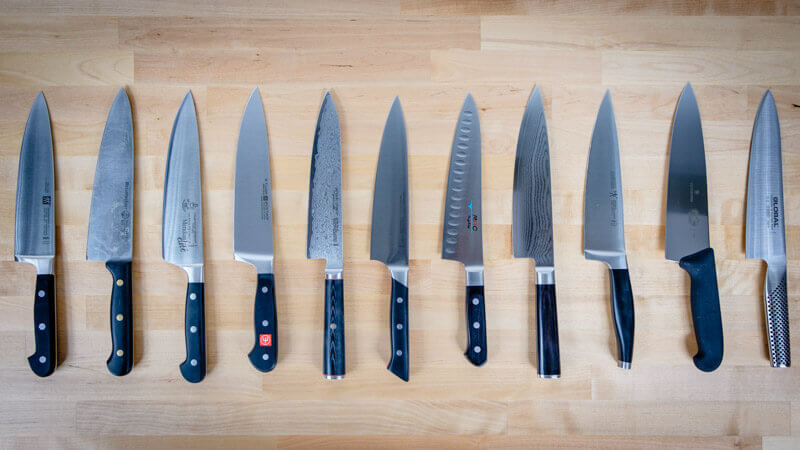
How to Care for Your Chef Knife
Know which parts of your knife are which
No single feature makes a knife objectively better. Rather, they’re indicators of how the knife is designed to perform. But it’s good to know the names of each feature to understand your personal preferences.
- Knife butt: The back end of your handle.
- Knife heel: The back end of the blade, closest to your fingers.
- Knife tip: The front half of the blade. Not to be confused with the point.
- Knife point: The literal pointy bit at the end of the knife.
- Knife edge: The sharp side of the blade. Be careful.
- Knife spine: The top of the blade. Some people place their index fingers along the length of the spine as they chop, but this is considered bad technique.
- Knife Tang: The steel that extends past your knife blade and into the handle. When a knife has a full tang, it means the steel goes all the way to the butt.
- Knife Bolster: The thick band of steel between the knife handle and the knife heel. A full bolster extends all the way into the heel; a half bolster stops before the heel. Some knives have no bolster at all.
- Granton Edge: The dimples on the blade. Not all knives have them. In theory, these stop food from sticking as you chop.
Keep your chef knife properly sharpened
If you buy a professional knife, you need to keep an edge on it, otherwise it’s like owning a car and not putting fuel in it.
If there’s a professional knife sharpener in your area, you can outsource the task. If not Shun offer mail-in sharpening for free. You can also learn to sharpen your knife yourself.
Learn the right way to chop
If you’re looking to improve your chopping game, these tips can help:
- Imagine your cutting board is a clock. Most people point their knife toward noon, placing the food horizontally across the cutting board. But if you angle your knife so that it points toward 10 o’clock (and adjust your food to stay parallel), the knife becomes an extension of your forearm and is easier to handle.
- Keep your knife in contact with your cutting board or work surface. There’s no need to lift it off the cutting board for each cut.
Only use your knife on food. A chef’s knife is your most important kitchen tool. Buy a pair of kitchen shears for boxes and bags!
Avoid the dishwasher
Regardless of manufacturer instructions, never put your chef knife in the dishwasher. And while you’re at it, never toss it into the sink. Every time the knife blade bangs against something (like the plastic spines of your dishwasher or the metal sides of your sink) it has the potential to dull, and you want to keep the blade as sharp as possible for as long as possible.
Instead, wash your knife by hand with standard dish soap, then use a clean dish towel or paper towel to rub it completely dry. (If you let it air-dry, it can develop water stains or rust spots.)